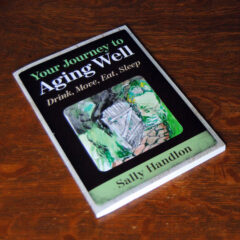
Sally Handlon has not written a “self-help” book with Your Journey to Aging Well: Drink, Move, Eat, Sleep. She has written a guide full of information, tips, and relatable personal stories that make reading this book feel more like having a cup of coffee with a friend who is genuinely concerned for your health.
The book starts with a biology recap of body systems, which is important because it creates a relevance for you the reader about the reasoning and language utilized in the suggested whys and hows that come later in the book.
It may seem a little like Biology 101 at times, but the refresher was good for me as I haven’t been in a biology class in over decades. Unless you have a child and are helping them with their homework and learning about human biology, the start of this book will be a great reminder of what you once knew and may have forgotten.
The following chapters are in the order they appear in the subtitle; Drink, Move, Eat, and Sleep. They are not just about drinking more water, exercising regularly, eating healthy, and sleeping better; it’s much more than that.
There are a few key takeaways from the book that I must share with you, especially if this post is as far as you get into the title.
“Our sense of thirst diminishes with age. Therefore, there may be fewer triggers to encourage us to drink water.” This was news to me, but it makes sense and gives me more of an impetus to drink more water. I’m not as young as I used to be, so clearly my sense of thirst isn’t what it used to be either.

Author Sally Handlon
“The World Health Organization (WHO) regards sleep loss as an epidemic in most Western nations.” This is something that I will likely look into on a greater scale at some point, as I’m personally interested in such a common occurrence being classified as an “epidemic” by the WHO.
“Practice deep breathing, which is good for your heart, circulation, and mind and for stress reduction–four benefits in one!” My old friend Nick DeMarco spoke of meditation on The Palmer Files Episode 34, and countless others have talked to me about the meditative parts of yoga. At minimum, deep breathing seems like it’s worth the time and energy.
There’s far more to this book than what I’ve just conveyed, but it should be enough to get you interested. Sally has created a health and wellness doctrine without being pushy or preachy. She relates personal stories and factual information along with easy-to-follow tips and tricks, plus there are worksheets available in the chapters, in the appendix, and on her website for your personal use.
It’s also worth mentioning the art in the book; the cover and chapter pieces are beautiful works by artist Robert L. Huetter. Sally’s guide is helpful in all its forms, but I’m sure the audio book lacks a bit without Huetter’s contributions.
Your Journey to Aging Well may even improve the quality of your life, but that part is not up to Sally. She only wrote it; it’s up to you to put what you learn into practice.
Read the Secret File of technical information and quotes from Your Journey to Aging Well.